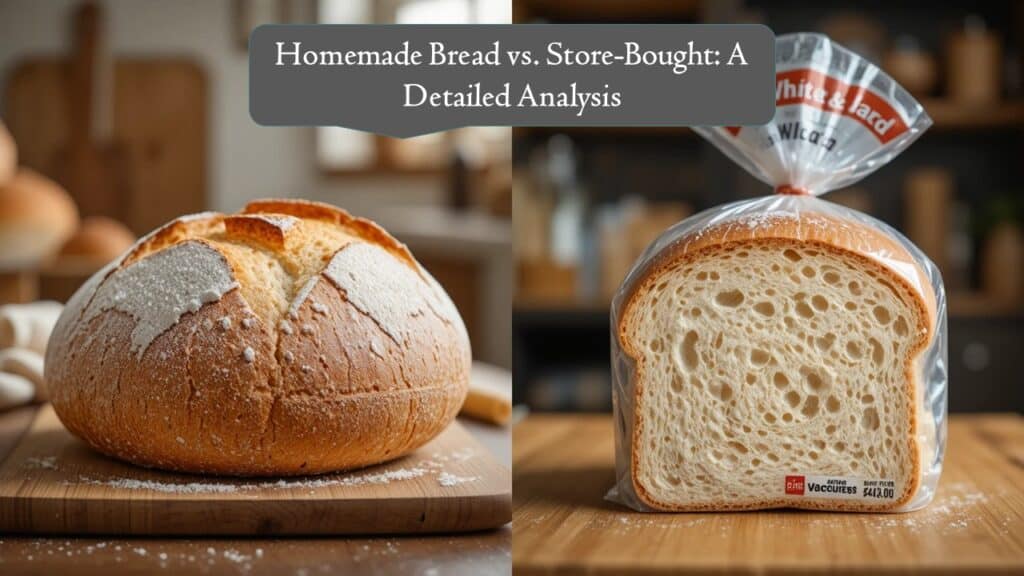There’s something magical about the smell of freshly baked bread wafting through your kitchen — it’s warm, nostalgic, and comforting. Yet, in the modern world, convenience often wins, and many people reach for a loaf of store-bought bread instead.
So, the question arises: Is homemade bread really better than store-bought bread?
This detailed analysis explores the differences between homemade and store-bought bread in terms of ingredients, nutrition, taste, cost, and convenience. By the end, you’ll have a clear understanding of which option best fits your lifestyle and priorities.
The Key Difference Between Homemade and Store-Bought Bread
At the most basic level, the difference lies in control.
- Homemade bread gives you full control over ingredients, freshness, and flavor.
- Store-bought bread, on the other hand, prioritizes shelf life, consistency, and mass production efficiency.
This fundamental difference impacts everything from taste and texture to nutritional value and cost.
Comparison Table: Homemade Bread vs Store-Bought Bread
| Feature | Homemade Bread | Store-Bought Bread |
| Ingredients | Simple, natural (flour, yeast, water, salt) | Often includes preservatives, conditioners, and added sugars |
| Shelf Life | 2–3 days (longer if frozen) | 1–2 weeks due to preservatives |
| Taste & Texture | Fresh, rich aroma, customizable crust | Consistent but less flavorful |
| Nutritional Value | High (depends on ingredients used) | Varies; may contain additives or refined flour |
| Cost | Lower per loaf (especially over time) | Convenient but can be more expensive |
| Time & Effort | Requires preparation and baking | Ready to eat immediately |
| Customization | Fully customizable | Limited to brand options |
| Environmental Impact | Minimal packaging, sustainable | Packaged in plastic, higher production footprint |
Ingredients and Additives
One of the biggest distinctions between homemade and store-bought bread is what goes into the loaf.
Homemade Bread
Homemade bread typically contains 4 to 6 simple ingredients — flour, yeast, salt, water, and sometimes sugar or oil. That’s it. No artificial additives or preservatives. You can also choose the flour type — whole wheat, multigrain, gluten-free, or organic — based on your preferences and dietary needs.
Bonus: You can incorporate natural flavorings like seeds, herbs, or honey without worrying about chemical additives.
Store-Bought Bread
To extend shelf life and maintain consistency, commercial breads often include:
- Preservatives (like calcium propionate or sodium benzoate)
- Dough conditioners (such as mono- and diglycerides)
- Added sugars for taste and browning
- Bleached or refined flour, which has fewer nutrients
These additions aren’t necessarily harmful in small quantities, but they do make store-bought bread less natural and nutrient-dense compared to its homemade counterpart.
Verdict: Homemade bread wins for ingredient transparency and purity.
Nutritional Value and Health Impact
Bread can be part of a healthy diet, but its nutritional quality varies depending on how it’s made.
Homemade Bread
- You control the flour type, which means you can use whole grains rich in fiber, B vitamins, and minerals.
- You can reduce sodium and sugar according to your preference.
- Fresh homemade bread doesn’t contain trans fats or chemical additives.
Store-Bought Bread
While some store brands offer whole-grain or fortified loaves, many varieties rely on refined white flour, which lacks fiber and nutrients. Additionally, some loaves contain hidden sugars, especially in “soft” sandwich breads.
Verdict: Homemade bread is generally more nutritious and adaptable to your dietary goals.
Taste and Texture
There’s a clear sensory difference between a loaf made in your oven and one from the supermarket shelf.
Homemade Bread
- Flavor: Rich, slightly nutty, and authentic.
- Texture: Chewy, soft, and warm — especially when fresh.
- Aroma: The smell of baking bread alone is unbeatable.
You can experiment with crust styles, kneading techniques, or even sourdough starters for deeper flavor.
Store-Bought Bread
Commercial bread is uniform in taste and texture — soft, spongy, and designed to stay consistent. While convenient, it lacks the character of fresh-baked loaves.
Verdict: Homemade bread easily takes the crown for flavor and sensory experience.
Shelf Life and Storage
Homemade Bread
Because it lacks preservatives, homemade bread typically lasts 2–3 days at room temperature. You can extend its life by:
- Storing it in a bread box or airtight container, or
- Freezing it, where it stays fresh for up to 3 months.
Store-Bought Bread
Preservatives give commercial bread a shelf life of 1–2 weeks, making it ideal for busy households that prefer convenience. However, once opened, it may lose freshness quickly.
Verdict: Store-bought bread wins in longevity, but homemade bread can compete if frozen properly.
Cost and Convenience
Homemade Bread
While it takes more time and effort, homemade bread can be more cost-effective in the long run. A basic loaf costs just a fraction of the price of artisanal or organic store brands, especially if you bake regularly.
However, it requires time investment — mixing, rising, and baking — and possibly a bread maker if you want automation.
Store-Bought Bread
You can’t beat the convenience: grab a loaf off the shelf, and you’re done. It’s perfect for people with busy schedules or limited baking equipment.
Verdict: Store-bought bread wins for convenience; homemade bread wins for long-term savings.
Customization and Variety
Homemade bread gives you the freedom to get creative:
- Want whole grains? Add oats or seeds.
- Prefer something sweet? Try honey or dried fruits.
- Need gluten-free? Choose specific flour blends.
Store-bought bread offers many varieties too, but they’re limited to what’s available in the market and may contain unnecessary fillers.
Verdict: Homemade bread allows full personalization.
Environmental and Ethical Considerations
Homemade bread often has a smaller environmental footprint — fewer transport emissions, no plastic packaging, and local ingredient sourcing. Store-bought bread, on the other hand, involves industrial production, plastic wrapping, and shipping.
If sustainability is your priority, homemade bread is the greener option.
Verdict: Homemade bread supports sustainable living.
Homemade Bread:
Pros:
- Natural, preservative-free ingredients
- Superior taste and aroma
- Customizable recipes
- Environmentally friendly
- Potentially cheaper long-term
Cons:
- Shorter shelf life
- Time-consuming
- Requires baking skills and equipment
Store-Bought Bread:
Pros:
- Extremely convenient
- Longer shelf life
- Consistent texture
- Wide variety of brands
Cons:
- May contain additives and preservatives
- Less flavor and aroma
- More expensive over time
- Plastic packaging waste
Conclusion: Which Is Better — Homemade or Store-Bought Bread?
Choosing between homemade and store-bought bread ultimately depends on your lifestyle and priorities.
If you value freshness, control, and natural ingredients, homemade bread is unbeatable. It’s more nutritious, flavorful, and satisfying — not to mention the joy of baking something from scratch.
However, if convenience and consistency matter most, store-bought bread is a practical option. It’s quick, accessible, and saves you time on busy mornings.
My Recommendation:
For the best of both worlds, try combining both options:
- Bake at home on weekends to enjoy fresh loaves.
- Use store-bought bread during hectic weekdays for quick meals.
This balanced approach ensures you get both the health benefits of homemade and the convenience of commercial bread.







